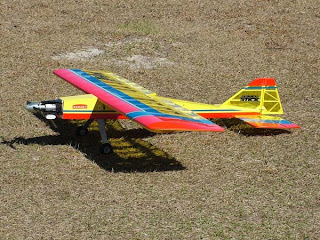I got my 60 sized Ultra Stick ready to fly and took it to Tangerine Field for the test flights. Yesterday, the wind was gusting up to about 30 miles per hour and it died down some today. The wind was gusting up to about 15 or 20 mph today. I don't always mind flying in the wind but the Ultra Stick is a very light airplane which makes some difference. I have never seen the wind blow straight down the runway at Tangerine Field and today was no different. There was a 90 degree crosswind. But, before I go there, let me back up and tell you about the Ultra Stick 60.
First of all, the Ultra Stick is designed for .60 to .90 sized engines. I originally put my Fox .74 on the airplane but no matter how I tried, I could not get the engine to continue to run. I almost burned up my starter. Finally, I put my trusty O.S. .61 FX in the plane. O.S. engines are the cream of the crop. Yes, you will pay more money for one but the reliability just can't be beat. I had to add about a half a pound of weight to the tail of the Ultra Stick to get it to balance. I HATE having to add weight to airplanes but they have to balance! The elevator and rudder use plastic housings with wire pushrods. When I put the wire in, it would barely move. It was bound up so badly that there is no way the airplane could be flown that way. So, I made pushrods the old fashioned way with wooden dowels. After ripping the plastic housings out of the airplane and then cutting larger exit holes for the pushrods, I had them in. That took me a couple of hours extra. I wasn't too happy but this is what happens when you buy ARF (Almost Ready to Fly) airplanes. I called Hangar 9 and they said they had never heard of that problem before and they would send me out a couple of new pushrods. LOL, a lot of good that does. Maybe I can use them on a differenc airplane.
Once I had the OS engine in the plane, I loaded it up in my Olds Alero. It was a tight squeeze but I got it in there and I was off to the field. Once at the field, I had to make a small adjustment on the throttle pushrod, then I was ready to fly. The plane took off without any problems. The .61 proved to be plenty of power for the airplane. I almost always use the largest engine recommended for an airplane but this airplane comes in at right around 6 pounds and the .61 was plenty of power. I flew it around a little bit and got it trimmed out and then decided to come in for a landing. As light as the plane is, I really had to "fly the rudder" on landing. The airplane wanted to come in absolutely sideways. The plane landed very slowly with some rudder input. I took the plane off again and tried a roll and then, with a lot of altitude, put in full flaps. the nose pitched up high. I will need to set the radio to compensate with some down elevator when the flaps are activated. I set the wing up on the Ultra Stick to "crow". Crow is where the flaps go down and the ailerons go up. The airplane is supposed to fly very slow in this configuration. As I get a little more familiar with the plane, I'll try the crow out.
I landed the plane again with a lot of rudder input and was very happy with the very slow landing. I sat down for awhile and when I got ready to take off again. The engine was making a LOT of noise at idle. I knew something was loose so I shut the engine off and found that the firewall was not glued into the airplane very well. This is a typical problem with ARF's that I have found. I had a Goldberg Skylark 56 ARF that after one flight the nose wheel came unbolted and I had to cut a huge hole in the bottom of the fuselage to fix it. My floatplane, a Tower Hobbies .60 sized trainer was held together by the covering material. I think someone forgot to glue the fuselage together! I brought the Ultra Stick home after finding the firewall loose. I'll have it glued up tonight and hopefully the wind will die down tomorrow.
Overall, the Ultra Stick seems to be a pretty nice plane although it falls into the same category as all of the other ARF's I've had, bad gluing and not very good quality control. The price seems a little high to me and it is a large airplane for a .60 sized airplane. For those of you, like me, that are trying to stuff this plane into a small car, you may want to opt for the .40 sized plane.




1 comment:
Hi Jay! I've had/have several US 60's. All of them had needed glue before first flight.
Re adding lead. I've flown mine with a Saito 100 (favorite), a 115, a 125 and the G20 Saito gas (also a 1.25ci - bob'ed the nose 1" for this one). Heavy weight up front with each. I put the elevator and rudder servos in the tail - just cut out, put some plywood reinforcing in and done. Also, you can make a hatch in the fuse about 6" behind the wing trailing edge, and put the battery pack there. NO LEAD = better performance!
Lynn Gordon
Post a Comment